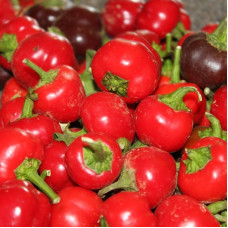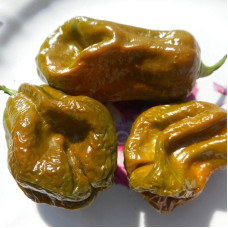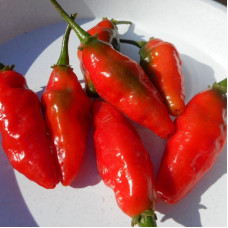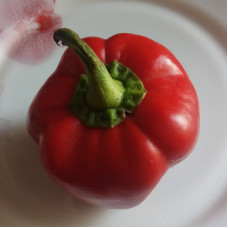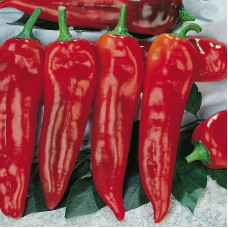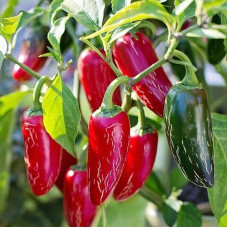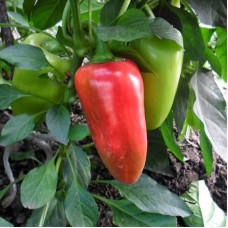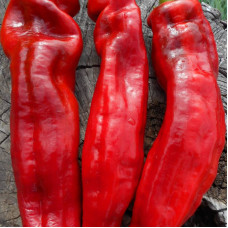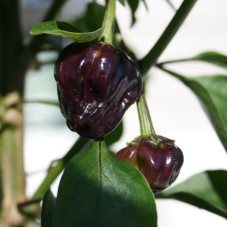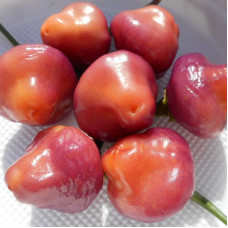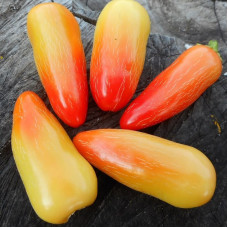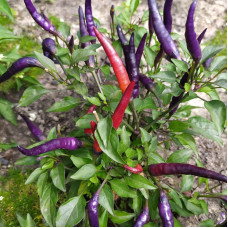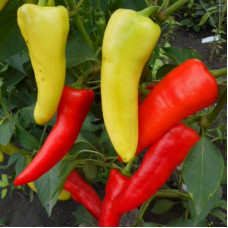In stock
Product Code: 10104
Sweet pepper «Mini bell red» - is a mid-season variety. The fruits are red, 10 grams, cube-shaped, thick-walled. Early ripening. The height of the bush is 30 cm. There are a lot of aromatic, sweet peppers on the bush, ideal for canning and freezing.
..
$0.99
In stock
Product Code: 12324
Hot (bitter) pepper «Comstock purple» - is one of the most amazing peppers. It grows about a meter and produces elongated conical pods that start green and purple and end in dark red and purple. Absolutely stunning view and incredible yield! A little..
$1.99
In stock
Product Code: 15005
Hot pepper (bitter) «Deng Long Jiao» - is a popular variety of hot pepper in Chinese cuisine. The fruits are deep red, heart-shaped, with a dense thin skin and a smoky aroma. The taste is spicy-salty. It can be used in large quantities in the prepara..
$0.99
In stock
Product Code: 12333
Hot (bitter) pepper «Habanero green» - a hybrid of Habanero Harolds St. Barts and Habanero Brown. Originally from the Caribbean. The spiciness is decent, similar to Caribbean Red. Not for fresh consumption, but for sauces! Can be frozen. Intense quin..
$2.99
In stock
Product Code: 12719
Hot pepper (bitter) «Jalapeno purple» - is a type of chili pepper, small in size, which is valued for its special pungency that remains in the mouth after eating. A purple twist on the classic Jalapeno, but overall it doesn't look too much like the «..
$1.99
In stock
Product Code: 12976
Hot pepper (bitter) «Mini Purple» - is a compact bush, height - 40 cm. Small-leaved variety with dark green leaves and black conical fruits when not fully ripe. Ripe fruits turn red, small in size, 5-6 times larger than a match head. Maturation is ea..
$1.99
In stock
Product Code: 14989
Hot pepper (bitter) «PI 310888» - late-ripening variety. Vegetation period from 160 days. Medium-sized cone-shaped fruits from green to red when fully ripe. The spiciness is low to moderate, but fruits and medium spicy can come across. Fruit walls ar..
$0.99
In stock
Product Code: 13681
Hot pepper (bitter) «Portokolova Fifronka» - a variety of hot peppers originally from Macedonia. The variety is old and very popular in the Balkans. The fruits are orange-pink in color. Plant height up to 1 meter. The variety is very productive and s..
$0.99
In stock
Product Code: 12714
Hot pepper «Serpent Noir» - grows beautifully, compact bushes, the peppers themselves are very interesting - with an uneven bumpy surface and shiny. The anthocyanin color depends on the sun, the upper fruits are always perfectly black, and in the dep..
$0.99
In stock
Product Code: 9783
Sweet pepper «Alenka»
An early ripe variety of sweet pepper. Vegetation period - 115-120 days. The plant is undersized, 50-60 cm high. The fruits are flat-round, ribbed, in technical ripeness - dark green, in biological ripeness - rich red, fleshy..
$0.99
In stock
Product Code: 14994
Sweet pepper "«Citrine» - mid-early variety (100-18 days). The height of the bush is 70cm. The fruits are elongated-cubic, weighing up to 160 grams, wall thickness - 8mm. Delicious, juicy, aromatic. In technical ripeness, the fruits are yellow, and i..
$0.99
In stock
Product Code: 7958
Sweet pepper «Corno di Toro Rosso» - mid-season variety, fruits ripen 125 days after germination. They reach a length of 18-30 cm, and weigh 150-180 grams. The color is red or yellow. Walls of average thickness - about 5 mm. The shape is conical-elon..
$0.99
In stock
Product Code: 11339
Sweet pepper «First swallow»
Early maturing variety. Vegetation period 115-120 days. This indoor variety has a standard, semi-spreading bush up to 70 cm high. The fruits are cone-shaped, up to 10 cm long, salad / red color, fruit weight up to 100 ..
$0.99
In stock
Product Code: 14991
Hot pepper (bitter) «Jalapeno Chichimeca» - is a mid-season variety. Terms from planting to ripening 100 days. The fruits are cone-shaped, thick-walled, short 6 cm long, weighing 50 grams. When fully ripe, the fruits turn red with a mesh pattern in t..
$0.99
In stock
Product Code: 11799
Sweet pepper «Merchant» - an early ripe variety for open ground and film greenhouses. The period of seedlings before fruiting is 110-112 days. The bush is semi-spreading, 75-85cm high. The position of the fruit on the plant is drooping. The fruits ar..
$0.99
In stock
Product Code: 12320
Sweet pepper "«Ramiro» - a medium-early variety, the ripening period of the pods ranges from 115 to 130 days. The height of the bush is 60cm. Long red peppers up to 25 cm. Wall - 5 mm, weight 100-150 grams. The fruits are tasty, sweet and fragrant.
..
$0.99
In stock
Product Code: 12962
Hot pepper (bitter) «Bhut Jolokia Red» - mid-season variety. From planting in the ground to harvesting, you need to wait 100-125 days. It is one of the hottest chili peppers in the world. The plant is slow growing, it can reach a height of 120 centim..
$0.99
In stock
Product Code: 12721
Hot pepper (bitter) «Black scorpion tongue» - is a beautiful and productive plant with dark leaves. Early from planting to ripening 80-90 days. The fruits start out dark purple, then fade to green and brown, and when fully ripe, dark red. Lilac flowe..
$1.99
In stock
Product Code: 12972
Hot (bitter) pepper «Cheiro roxa» - the branches are dark in color, the leaves are blue-green. Unusual fruit shape. Ripe fruits are cream-colored with purple striations and grow in bunches of 3 to 6 in one node. The taste and aroma are fruity. The fr..
$1.99
In stock
Product Code: 12336
Hot (bitter) pepper «Jalapeno white» - is a type of chili pepper, small in size, valued for its special heat that remains in the mouth after eating. Creamy in color, juicy, meaty, thick walls and fruity aroma. Very compact low-growing bush, abundant ..
$1.99
In stock
Product Code: 12967
Hot pepper (bitter) «Kashmiri mirch» - belongs to the Cayenne varietal group. Very popular in India. The plant is tall up to 1,2 meters. A garter to the support is required. A productive variety. It is mainly dried and ground into powder. Very strong..
$0.99
In stock
Product Code: 15393
Hot pepper (bitter) «Masquerade» - is a mid-early decorative and productive variety. Compact plant, bush height 30-40cm. The fruits are elongated-conical in shape. When ripe, it changes color from purple to red through yellow and orange. The calyx of..
$1.99
In stock
Product Code: 15394
Hot (bitter) pepper Mulato» - is an early-ripening variety of the Poblano type, but less spicy and milder. The height of the bush is 50-70cm. Large cone-shaped fruits with wrinkled skin ripen from dark green to dark chocolate color.
Dried fruits a..
$1.99
In stock
Product Code: 14999
Hot pepper (bitter)«Petlyakivskyi» - a family heirloom of the Petlyak family. Unique large-fruited cone-shaped hot pepper. Differs in high productivity of fruits practically identical by the size.
When ripe, the fruit changes color from light gree..
$0.99
Pepper Features
Today, there are over 700 types of pepper seeds. Initially, this word denoted a genus of plants of the Pepper family. Now this terminology is used depending on the scope. In cooking, there are three main types: white, green, black. Their difference is only in ripeness and time of collection. A popular variety is the thick-walled specimen.
Initially, pepper appeared in Mexico and Guatemala, Columbus brought it to Europe, like potatoes. First, he was entrenched in the culinary culture of Spain, then England, Hungary, Greece, Bulgaria. It appeared on our territory in the sixteenth century and took root so much that local farmers began to seat it at an enviable speed. And with the advent of science in human life, peppers were found to be bred, creating hybrid species and all kinds of product variations. After 5 centuries, this vegetable has not lost its former popularity, but has only become even more firmly entrenched in the gastronomic cult of almost all countries of the world.
Pepper dishes have been familiar to us since childhood, it can be stuffed, baked, canned or chopped into lecho. Unfortunately, today's prices make it an unaffordable luxury to be able to buy natural vegetables. For residents of country houses, this is all the more not the most rational solution. Therefore, more and more people do without shops, growing vegetable products in the garden. Do not be upset or the inhabitants of the apartments – some peppers can be grown in a pot. To carry out this process, only favorable conditions for the life of the plant and high-quality pepper seeds are needed, which will be discussed further.
Initially, pepper appeared in Mexico and Guatemala, Columbus brought it to Europe, like potatoes. First, he was entrenched in the culinary culture of Spain, then England, Hungary, Greece, Bulgaria. It appeared on our territory in the sixteenth century and took root so much that local farmers began to seat it at an enviable speed. And with the advent of science in human life, peppers were found to be bred, creating hybrid species and all kinds of product variations. After 5 centuries, this vegetable has not lost its former popularity, but has only become even more firmly entrenched in the gastronomic cult of almost all countries of the world.
Pepper dishes have been familiar to us since childhood, it can be stuffed, baked, canned or chopped into lecho. Unfortunately, today's prices make it an unaffordable luxury to be able to buy natural vegetables. For residents of country houses, this is all the more not the most rational solution. Therefore, more and more people do without shops, growing vegetable products in the garden. Do not be upset or the inhabitants of the apartments – some peppers can be grown in a pot. To carry out this process, only favorable conditions for the life of the plant and high-quality pepper seeds are needed, which will be discussed further.
Pepper seed classification
As mentioned, there are an incredible number of varieties. So many that a person who has no experience in agriculture will not understand what's what. & nbsp; Of all the species and subspecies classifications, one can single out the most familiar to every European. Pepper seeds are divided into the following types:
- Hot pepper. The most popular variety is chili, even hotter Jalapeno, waxy Hungarian, Jamaican, red Cherry pepper and others. Despite the pungency, they contain a large amount of useful substances. They are digestion catalysts, used for chronic diseases, diseases of the stomach and intestinal tract in some cases. In the East, flatulence is cured with the help of the pungent Habanero. Due to its small size in most species, it is well suited for growing at home. The process of sowing seeds is recommended to be carried out in winter. You also need to carefully approach the preparation of the soil, laying it out in layers: humus, leafy soil, sand. Indoor hot pepper bushes do not respond well to transplantation, so you need to take care of the "growth" pot in advance.
- Sweet pepper. The second name, which is more popular, is Bulgarian. There are different colors: from yellow to purple. Growing this type is a more complicated procedure and is unlikely to suit inexperienced farmers. Preparing for planting takes a lot of time and knowledge. Sowing pepper seeds – the beginning of the most crucial period, ending with the emergence of seedlings. After all, on the "conscience" the seeds themselves are only 20% failures, 80% - non-compliance with growing technologies. Therefore, it is more reliable to sow germinated seeds for seedlings, which reduce the likelihood of poor germination. To begin with, the purchased seeds must be soaked in infused water with aloe leaves or a small amount of potassium permanganate. This will not harm the plant in any way, but rather relieve harmful bacteria and damage. Seeds should be watered abundantly until the first leaves appear.
How to choose seeds
There are no special technologies for choosing pepper seeds, they are the same and differ in what fruits we get at the end. It is worth choosing, starting from the place of residence: a private house or an apartment. Also, an important factor in choosing is whether it is late or early. The first type matures in about 140 days, while the second takes almost half the time. It is imperative to find out if you are allergic to one or another variety, since this product can also have a negative effect on a sick organism.

